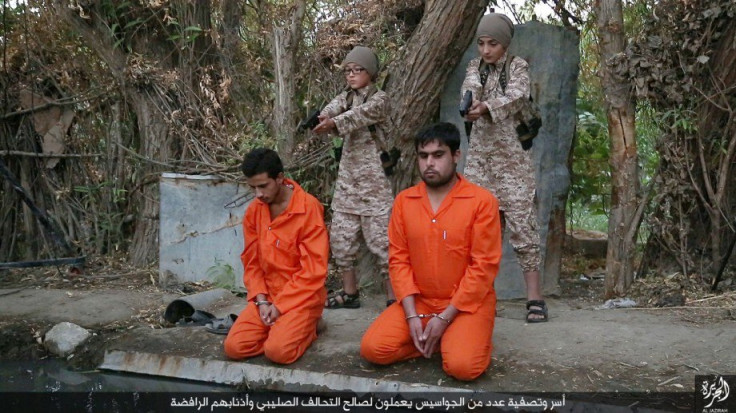As 300 Isis 'Caliphate Cubs' fight in Mosul, analysts say we shouldn't be shocked
Analysts say Islamic State's child soldiers are intended to scare the world.
The latest development in the battle to retake Mosul from Islamic State (Isis) is one that has shocked the world.
More than 300 IS (Daesh) child soldiers, known as 'Caliphate Cubs', were killed as US-backed Iraqi forces advanced into the country's city, which was once the heart land of the terror group's territory.
Though the use of child soldiers was a scandalous revelation, security analysts and researchers argue it is nothing new in the context of warfare.
"Children are systematically trained to fulfil roles ranging from spies, to frontline soldiers, to suicide bombers," Noman Benotman and Nikita Malik said, in a 2016 study for the counter-extremism think tank Quilliam.
"Although the exploitation of children in such a manner is shocking to many audiences, it is an unfortunate fact that throughout history, children have been used in times of war."
What is new, is the extent that IS is using child soldiers for propaganda, Benotman and Malik argue.
Propaganda
One reason the IS was so successful in carving up its merciless caliphate across the Middle East was that its depravity shocked the world and the military units it came up against.
So frightened were the US-trained Iraqi soldiers by the terror group's disregard for human life, on many occasions they simply dropped their weapons and fled before joining battle with IS forces.
As the terror group established its territory, one thing was clear: the fear campaign IS created was no mistake.
Its operatives were proficient in YouTube, Instagram and Tumblr to promote its messages, and the videos it disseminated looked more like the work of an international broadcasting company than a backwards terror organisation hell-bent on instilling the most radical and extreme form of Islam imaginable across the Middle East.
The executioners in its videos spoke fluent English and their hostages were dressed in orange jumpsuits, symbolic of Guantanamo Bay.

When the Jordanian pilot Moaz al-Kasabeh was savagely burned alive in a cage, cameras were on standby at every angle to make sure no expression of his agony was left uncaptured. When the video was released, the different camera angles were stitched together as if it was the latest episode of 24.
But the new and troubling trend of IS using child soldiers in its grizzly propaganda videos, is unprecedented, Charlie Winter, a senior fellow at the International Centre for the Study of Radicalisation, argues.
"Isis has stepped up its efforts to force its juxtaposition of children and brutality upon the rest of the world," he wrote in a piece for the Guardian.
"In January [2015], a young Kazakh boy was filmed as he shot a man in the back of the head; in March, Isis propagandists released a video in which a French child aged no more than 11 executed a Palestinian accused of spying for the Israeli government; in May, a young Russian was shown doing the same to an alleged member of the Federal Security Service; in June, 25 teens were filmed as they each shot a pro-Assad regime soldier in Palmyra's Roman Theatre; and, less than a month later in July, Isis supporters circulated footage of a young Syrian boy beheading an officer, also in Palmyra.
"This downward spiral of depravity arguably reached its nadir in December, when six small boys were shown playing Isis 'hide-and-seek', running through the ruins of a castle in eastern Syria, racing each other to kill one of the handful of captives who were tied up and defenceless inside."

Benotman and Malik said there were 254 instances between 1 August 2015 and 9 February 2016 where children were used in IS propaganda videos.
However, just as before, the videos are professional, well edited and with a particular audience in mind.
"There exists… an external strategic element to IS' recruitment of children," Benotman and Malik said.
"It allows IS leaders to gain the psychological upper hand against their opponents because their videos of children performing brutal acts break the boundaries of international norms, thus drawing global attention and increasing global fear of the caliphate."
Winter argues a similar point in that IS's latest drive to feature children is a publicity stunt, at a time when the terror group is losing more ground than ever.
"Videos like these may gratify and excite supporters and show off a triumphalist, defiant 'caliphate', but they don't cause the curious to sign up," he said.
"More than being for sympathisers, they are meant more for IS's adversaries, both those fighting it and those observing it from afar. Locally, they are intended to deter rebellion and, globally, to provoke outrage and disgust.
"It is critical that we do not dismiss such actions as being inevitable outcomes of IS' being 'medieval' or a 'death cult'.
"IS may be brutal, but it is far from irrational. Its propagandists are paragons of cynicism and know all too well that they can seize and dictate the global media agenda through their audiovisual actions.
"IS' brutality is deliberately broadcast to the world because it breeds publicity. Crucially, though, it isn't just any publicity, it is publicity on IS' terms."

© Copyright IBTimes 2025. All rights reserved.






















